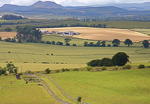Scottish farmland growth outpaces gold
The performance of Scottish farmland has outstripped that of gold, or English farmland in the second half of 2013 although there is diversity in the market


Scottish farmland reinforced it credentials as a solid investment in 2013 with prices rising on average by 7% to £4,262/acre in the latter half of the year, according to the Knight Frank Scottish Farmland Index.
Overall, values rose by 11% during the year, according to the report. This takes 10-year growth to 220%, and means for the first time that the value of Scottish farmland has outpaced the rise of land (210%) south of the border. It also puts land in Scotland ahead of gold (212%), perceived by many as the ultimate safe-haven asset.
James Denne, Head of Farm Sales in Scotland, says there is still confidence in the farming sector from both investors and agricultural businesses: 'Although farm profitability undeniably fluctuates in line with commodity prices, the value of the underlying asset - land - has continued to rise steadily and hasn't exhibited any of the volatility shown by other asset classes, such as gold. This is important because it gives banks the confidence to keep lending to the sector.'
* Subscribe to Country Life magazine and save
James reports strong interest in Lochmailing, an attractive livestock unit in Dumfries and Galloway, launched last autumn.
We have had a lot of enquiries from farmers, mostly Scottish, but also some from England, looking either for a standalone unit or as an addition to their current holdings.'
There was also competitive bidding for two 110-acre blocks in Fife that fetched between £7,000 and £8,400/acre. ‘There was strong demand from farmers,' commented James.
Exquisite houses, the beauty of Nature, and how to get the most from your life, straight to your inbox.
However, not all sectors of the market are growing at the same time, says Head of Scottish Farm Valuations Michael Ireland. ‘There is definitely continuing strength in the arable sector, particularly for the best soil, but a softening of growth in the more marginal stock and grassland areas is giving rise to a more diverse market both geographically and between productive types within the same locality.
Hill ground, for instance, is rising in price more slowly, possibly due to uncertaintly over subsidy payments for livestock farms under the latest CAP reforms.
* Follow Country Life magazine on Twitter

